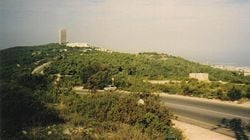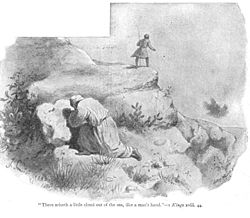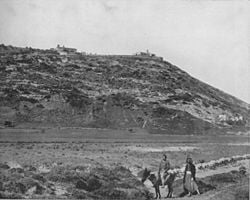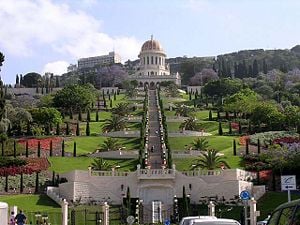Difference between revisions of "Mount Carmel" - New World Encyclopedia
m (→Later history) |
|||
| Line 1: | Line 1: | ||
{{Started}}{{Contracted}} | {{Started}}{{Contracted}} | ||
| − | [[Image: | + | [[Image:Nasahaifa.jpg|thumb|250|Carmel (left) and Haifa as seen from space]] |
| − | |||
'''Mount Carmel''' is a coastal [[mountain range]] in northern [[Israel]] overlooking the [[Mediterranean Sea]]. Its name is derived from the Hebrew "Karem El" which means 'vineyards of God'. In ancient times it was covered by vineyards and was at all times famous for its fertility. | '''Mount Carmel''' is a coastal [[mountain range]] in northern [[Israel]] overlooking the [[Mediterranean Sea]]. Its name is derived from the Hebrew "Karem El" which means 'vineyards of God'. In ancient times it was covered by vineyards and was at all times famous for its fertility. | ||
| Line 10: | Line 9: | ||
==Geography== | ==Geography== | ||
| + | [[Image:HaifaUniversity.JPG|thumb|right|250px|[[University of Haifa]] atop Mount Carmel in 1996]] | ||
| − | Mount Carmel is 16 miles long by 4-5 miles wide and 1,800 feet high. The city of [[Haifa]] is situated at the western promontory of Mount Carmel and partly at its base, | + | Mount Carmel is 16 miles long by 4-5 miles wide and 1,800 feet high. The city of [[Haifa]] is situated at the western promontory of Mount Carmel and partly at its base. |
| + | |||
| + | The sloped side of the mountain is covered with luxuriant vegetation, including [[oak]]s, [[pine]]s, [[olives]], and [[laurels]]. Several smaller towns are located on the range, including [[Yokneam]] on the eastern ridge, [[Zikhron Ya'aqov]] on the southern slope, the [[Druze]] town of [[Carmel City]] on the more central part of the ridge, and the towns of [[Nesher]], [[Tirat Hakarmel]]. | ||
==Biblical Carmel== | ==Biblical Carmel== | ||
| − | In the Bible, Carmel is first mentioned as the location a Jokneam, a twon conquered by Joshua (Josh. 12:22). It is also mentioned as the western boundary of the tribe of Asher (Josh. 19:24). King [[Saul]] reportedly established a victory monument there after his victory over the [[Amalekites]] (1 Samuel 15:12). Carmel was also the home of David's wise wife [[Abigail]] and her first husband, the wealthy but foolish Nabal (1 Samuel 25). | + | In ancient [[Canaan]]ite culture, [[high places]] were frequently considered to be sacred, and Mount Carmel appears to have been no exception. Human habitation there dates back to Neanderthal times, and it fame as a sacred site could date back to the fifteenth century B.C.E., when it may have been known to the Egyptians. |
| + | |||
| + | In the [[Bible]], Carmel is first mentioned as the location a Jokneam, a twon conquered by Joshua (Josh. 12:22). It is also mentioned as the western boundary of the tribe of Asher (Josh. 19:24). King [[Saul]] reportedly established a victory monument there after his victory over the [[Amalekites]] (1 Samuel 15:12). Carmel was also the home of David's wise wife [[Abigail]] and her first husband, the wealthy but foolish Nabal (1 Samuel 25). | ||
[[Image:Elijah-rain.jpg|thumb|250px|Elijah prays for rain after the battle at Mount Carmel, as his servant spots a tiny rain cloud in the distance.]] | [[Image:Elijah-rain.jpg|thumb|250px|Elijah prays for rain after the battle at Mount Carmel, as his servant spots a tiny rain cloud in the distance.]] | ||
| Line 21: | Line 25: | ||
Elijah's protege, the prophet Elisha maintains a dwelling place at Carmel during his own ministry (2 Kings 4:25). The prophet Amos speaks as Carmel as a place of supposed refuge which will not suffice on the day of God's reckoning (Amos 9:3}. It is refered to by the prophets [[Jeremiah]] (46:18) and Isaiah ( 35:2) as a symbol of majesty, and the male character in the Song of Solomon tells his beloved "Your head crowns you like Mount Carmel." (Song of Solomon 7:5) Jeremiah also predicts that Israel will one day return from exile, and Carmel will again be known as a rich pastureland from the nation's flocks (50:19). | Elijah's protege, the prophet Elisha maintains a dwelling place at Carmel during his own ministry (2 Kings 4:25). The prophet Amos speaks as Carmel as a place of supposed refuge which will not suffice on the day of God's reckoning (Amos 9:3}. It is refered to by the prophets [[Jeremiah]] (46:18) and Isaiah ( 35:2) as a symbol of majesty, and the male character in the Song of Solomon tells his beloved "Your head crowns you like Mount Carmel." (Song of Solomon 7:5) Jeremiah also predicts that Israel will one day return from exile, and Carmel will again be known as a rich pastureland from the nation's flocks (50:19). | ||
| − | == | + | ==Later history== |
| − | [[ | + | The Greak philosopher [[Pythagoras]] was reported attracted to Carmel by its sacred reputation. The future Emperor [[Vespasian]] went there during the Jewish Revolt of 66-70 C.E. to consult an oracle (Tacitus, "Hist." 2:78). By this time, [[Tacitus]] reports, Carmel was the name "both of the mountain and the Deity. They have no image of the god nor any temple; the tradition of antiquity recognizes only an altar and its sacred association." |
| − | + | ||
| − | + | [[Image:Mount-carmel-1894.jpg|thumb|left|250px|A view of Mount Carmel in 1894]] | |
| − | + | Carmel became a place of Christian piligrimage in the later Roman Empire. Crusaders on a pilgrimage to Mount Carmel in 1150 A.D. reportedly encountered a small Byzantine monastery there. It priests claimed that their when predecessors first arrived they had found a community of Jewish Christians who traced their roots back to pre-Christian times, dating back to the "son of the prophets" referred to in the stories of Elijah and Elisha. | |
| − | |||
| − | + | The [[Carmelite]] religious order was founded on Mount Carmel in the twelfth century. The order grew to be one of the major Catholic [[religious order]]s worldwide. Prefixed to the 1281 Carmelite Constitution was this statement: "''From the times when the prophet Elias and Eliseus dwelt devoutly on Mount Carmel, holy fathers both of the old and new Testament... lived praiseworthy lives in holy penitence by the fountain of Elias in a holy succession uninterruptedly maintained.''" | |
| + | |||
| + | Although no documentary evidence of such an ancient community exists, the prophet Elisha is said to have made a pilgrimage to Carmel after visiting communities of prophets further south and later himself dwelt there, so the suggestion is not implausible. | ||
| − | The | + | After the Muslim conquest, Carmel housed several [[mosques]]. The Carmelite mystics, St. [[Teresa of Avila]] and St. [[John of the Cross]] later reformed the Carmelite Order, and the Discalced Carmelites emerged from this tradition in 1593, reoccupying the ancient site on Mount Carmel. A new monestery was finished in 1853 and now school of philosophy associated with the [[Discalced Carmelite Order]]. |
| − | + | During [[World War I]], Mount Carmel played a significant strategic role. The modern [[Battle of Megiddo (1918)|Battle of Megiddo]] took place at the head of a pass through the [[Carmel Ridge]], which overlooks the [[Jezreel Valley|Valley of Jezreel]] from the south. [[Edmund Allenby, 1st Viscount Allenby|General Edmund Allenby]] led the British in the battle, which was the turning point in the war against the [[Ottoman Empire]]. | |
| − | + | [[Image:TerracesBenGurion2.jpg|thumb|300px|The [[Shrine of the Báb]] and its Terraces on Mount Carmel]] | |
| − | |||
| − | + | The [[Shrine of the Báb]], completed in the 1950s, is a Baha'i holy place located on the side of Mount Carmel in the middle of the [[Bahá'í Faith|Bahá'í]]-owned [[The Terraces (Bahá'í)|terraces]]. The remains of the Bahai [[Messiah]], [[the Báb]], first laid to rest within the primitive shrine there in 1909. Also located on Mount Carmel are a set of Bahá'í administrative buildings referred to as [[The Arc (Bahá'í)|the Arc]]. The location was designated by the Faith's founder in the [[Tablets of Bahá'u'lláh#Lawh-i-Karmil (Tablet of Carmel)|Tablet of Carmel]]. The mountain remains a sacred place for Bahá'ís around the world. | |
| − | + | Modern [[Essenes|Essene]] groups point that Mount Carmel was the spiritual stronghold of the northern Essene movement described by the Church Father [[Epiphanius of Salamis|Epiphanius]] in his ''Panarion'' (1:18) and briefly noted by the historian [[Josephus]] in his ''[[War of the Jews]]''. | |
| − | + | Excavations on Mount Carmel in 1958 uncovered what some believe to be [[Elijah]]'s altar, the cave where he lived, the "fountain of Elijah," and the remains of an ancient monastery. | |
| − | Mount Carmel | ||
| − | + | ==Archaeology== | |
| + | From 1930 to 1932, archaelogist [[Dorothy Garrod]] excavated Neanderthal and early modern human remains in the Carmel caves of el-Wad, el-Tabun, and es- [[Es Skhul]]."[http://www.athenapub.com/8timelin.htm] A [[Neanderthal]] female skeleton found there is considered one of the most important human fossils ever found. Later excavations produced the longest stratigraphic record in the region, spanning 600,000 or more years of human activity." <ref>[http://www.arch.cam.ac.uk/~pjs1011/Pams.html title needed]. ''www.arch.cam.ac.uk''. Retrieved August 21, 2007.</ref> | ||
==External links== | ==External links== | ||
| − | *[http://www.bibleplaces.com/mtcarmel.htm Mount Carmel | + | *[http://www.bibleplaces.com/mtcarmel.htm Mount Carmel]. ''www.bibleplaces.com''. Retrieved August 21, 2007. |
| − | |||
| − | |||
| − | |||
| − | |||
| − | |||
| − | |||
[[Category:nations and places]] | [[Category:nations and places]] | ||
{{Credit|123294010}} | {{Credit|123294010}} | ||
Revision as of 23:59, 21 August 2007
Mount Carmel is a coastal mountain range in northern Israel overlooking the Mediterranean Sea. Its name is derived from the Hebrew "Karem El" which means 'vineyards of God'. In ancient times it was covered by vineyards and was at all times famous for its fertility.
A Syrian Philosopher of the 4th century C.E., called Iamblichus, wrote that Mount Carmel was "the most holy of all mountains and forbidden of access to many."
Our Lady of Mount Carmel is a title given to Mary, the mother of Jesus, in honor of her having given the Scapular of Our Lady of Mount Carmel to Saint Simon Stock. Her feast is celebrated on July 16.
Geography
Mount Carmel is 16 miles long by 4-5 miles wide and 1,800 feet high. The city of Haifa is situated at the western promontory of Mount Carmel and partly at its base.
The sloped side of the mountain is covered with luxuriant vegetation, including oaks, pines, olives, and laurels. Several smaller towns are located on the range, including Yokneam on the eastern ridge, Zikhron Ya'aqov on the southern slope, the Druze town of Carmel City on the more central part of the ridge, and the towns of Nesher, Tirat Hakarmel.
Biblical Carmel
In ancient Canaanite culture, high places were frequently considered to be sacred, and Mount Carmel appears to have been no exception. Human habitation there dates back to Neanderthal times, and it fame as a sacred site could date back to the fifteenth century B.C.E., when it may have been known to the Egyptians.
In the Bible, Carmel is first mentioned as the location a Jokneam, a twon conquered by Joshua (Josh. 12:22). It is also mentioned as the western boundary of the tribe of Asher (Josh. 19:24). King Saul reportedly established a victory monument there after his victory over the Amalekites (1 Samuel 15:12). Carmel was also the home of David's wise wife Abigail and her first husband, the wealthy but foolish Nabal (1 Samuel 25).
Carmel's greatest claim to fame, however, was the battle that took place their between the prophet Elijah and the 450 prophets of Baal, together with 400 prophets of Ashera. Here the mountain, located in a kind of no-mans-land between Israel and Phoenecia, represents a strategic high ground where the Phoenician Baal and the Israelite Yahweh contend. Elijah puts the prophets of Baal to shame when he is able to produce fire from heaven to consume his sacrifice to Yahweh, while the prophets of Baal desperately fail to produce fire from Baal to consume their offering. Having proved his point spiritually, Elijah proceeds to order the assembled crowd of onlookers to slaughter the prophets of Baal in the valley below. He then prays to the Lord to end the drought, and a rain cloud appears in response to his plea.
Elijah's protege, the prophet Elisha maintains a dwelling place at Carmel during his own ministry (2 Kings 4:25). The prophet Amos speaks as Carmel as a place of supposed refuge which will not suffice on the day of God's reckoning (Amos 9:3}. It is refered to by the prophets Jeremiah (46:18) and Isaiah ( 35:2) as a symbol of majesty, and the male character in the Song of Solomon tells his beloved "Your head crowns you like Mount Carmel." (Song of Solomon 7:5) Jeremiah also predicts that Israel will one day return from exile, and Carmel will again be known as a rich pastureland from the nation's flocks (50:19).
Later history
The Greak philosopher Pythagoras was reported attracted to Carmel by its sacred reputation. The future Emperor Vespasian went there during the Jewish Revolt of 66-70 C.E. to consult an oracle (Tacitus, "Hist." 2:78). By this time, Tacitus reports, Carmel was the name "both of the mountain and the Deity. They have no image of the god nor any temple; the tradition of antiquity recognizes only an altar and its sacred association."
Carmel became a place of Christian piligrimage in the later Roman Empire. Crusaders on a pilgrimage to Mount Carmel in 1150 C.E. reportedly encountered a small Byzantine monastery there. It priests claimed that their when predecessors first arrived they had found a community of Jewish Christians who traced their roots back to pre-Christian times, dating back to the "son of the prophets" referred to in the stories of Elijah and Elisha.
The Carmelite religious order was founded on Mount Carmel in the twelfth century. The order grew to be one of the major Catholic religious orders worldwide. Prefixed to the 1281 Carmelite Constitution was this statement: "From the times when the prophet Elias and Eliseus dwelt devoutly on Mount Carmel, holy fathers both of the old and new Testament... lived praiseworthy lives in holy penitence by the fountain of Elias in a holy succession uninterruptedly maintained."
Although no documentary evidence of such an ancient community exists, the prophet Elisha is said to have made a pilgrimage to Carmel after visiting communities of prophets further south and later himself dwelt there, so the suggestion is not implausible.
After the Muslim conquest, Carmel housed several mosques. The Carmelite mystics, St. Teresa of Avila and St. John of the Cross later reformed the Carmelite Order, and the Discalced Carmelites emerged from this tradition in 1593, reoccupying the ancient site on Mount Carmel. A new monestery was finished in 1853 and now school of philosophy associated with the Discalced Carmelite Order.
During World War I, Mount Carmel played a significant strategic role. The modern Battle of Megiddo took place at the head of a pass through the Carmel Ridge, which overlooks the Valley of Jezreel from the south. General Edmund Allenby led the British in the battle, which was the turning point in the war against the Ottoman Empire.
The Shrine of the Báb, completed in the 1950s, is a Baha'i holy place located on the side of Mount Carmel in the middle of the Bahá'í-owned terraces. The remains of the Bahai Messiah, the Báb, first laid to rest within the primitive shrine there in 1909. Also located on Mount Carmel are a set of Bahá'í administrative buildings referred to as the Arc. The location was designated by the Faith's founder in the Tablet of Carmel. The mountain remains a sacred place for Bahá'ís around the world.
Modern Essene groups point that Mount Carmel was the spiritual stronghold of the northern Essene movement described by the Church Father Epiphanius in his Panarion (1:18) and briefly noted by the historian Josephus in his War of the Jews.
Excavations on Mount Carmel in 1958 uncovered what some believe to be Elijah's altar, the cave where he lived, the "fountain of Elijah," and the remains of an ancient monastery.
Archaeology
From 1930 to 1932, archaelogist Dorothy Garrod excavated Neanderthal and early modern human remains in the Carmel caves of el-Wad, el-Tabun, and es- Es Skhul."[1] A Neanderthal female skeleton found there is considered one of the most important human fossils ever found. Later excavations produced the longest stratigraphic record in the region, spanning 600,000 or more years of human activity." [1]
External links
- Mount Carmel. www.bibleplaces.com. Retrieved August 21, 2007.
Credits
New World Encyclopedia writers and editors rewrote and completed the Wikipedia article in accordance with New World Encyclopedia standards. This article abides by terms of the Creative Commons CC-by-sa 3.0 License (CC-by-sa), which may be used and disseminated with proper attribution. Credit is due under the terms of this license that can reference both the New World Encyclopedia contributors and the selfless volunteer contributors of the Wikimedia Foundation. To cite this article click here for a list of acceptable citing formats.The history of earlier contributions by wikipedians is accessible to researchers here:
The history of this article since it was imported to New World Encyclopedia:
Note: Some restrictions may apply to use of individual images which are separately licensed.
- ↑ title needed. www.arch.cam.ac.uk. Retrieved August 21, 2007.




